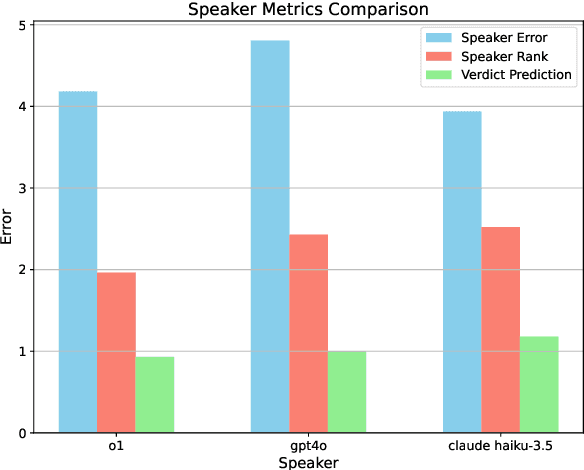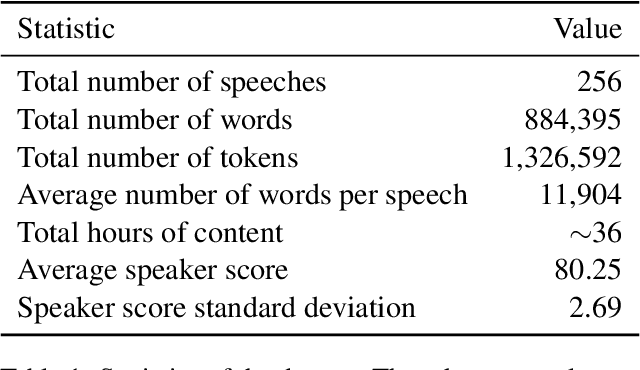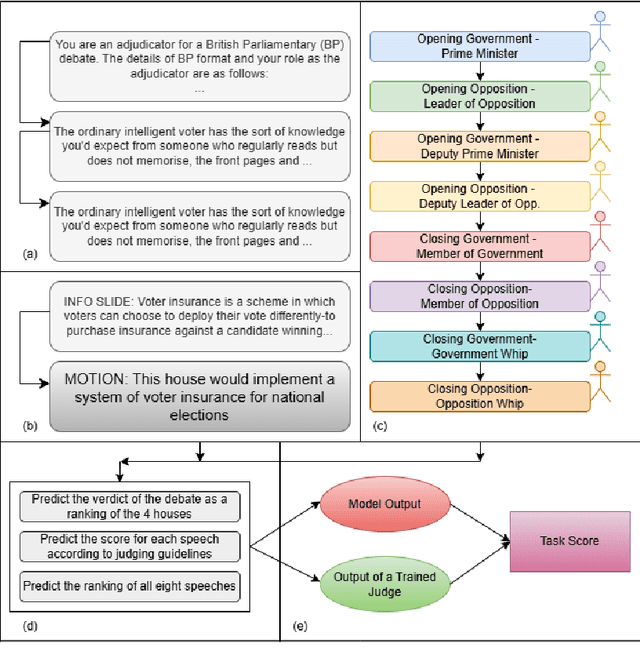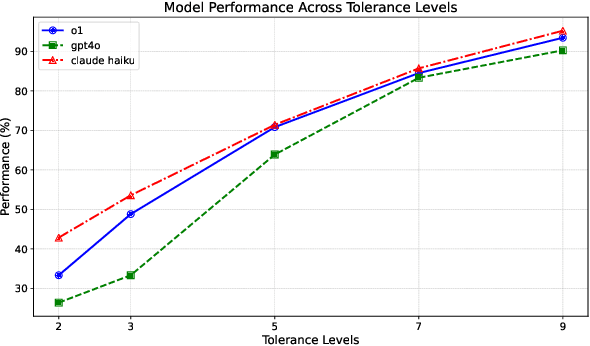Dhruv Kumar
Talking with Oompa Loompas: A novel framework for evaluating linguistic acquisition of LLM agents
Sep 09, 2025Abstract:Existing evaluation studies on linguistic competence of large language models (LLM agents) have focused primarily on vocabulary learning, morphological rule induction, syntactic generalization, pragmatic inference, and cross-linguistic transfer. However, none assess whether LLM agents can acquire a language through pattern recognition and interactive feedback, a central feature of human language acquisition. We propose a novel experimental framework in which an LLM agent is evaluated on its ability to acquire and use a newly constructed language (Tinkatongue) in conversation with a bot that understands only Tinkatongue. Our findings show that LLM agents fail to establish a conversation within 100 responses, yet they adopt distinct strategies that mirror human approaches to language learning. The results suggest a new direction for evaluation benchmarks and open pathways to model designs that learn more effectively from interactive feedback.
HAEPO: History-Aggregated Exploratory Policy Optimization
Aug 26, 2025Abstract:Exploration is essential in modern learning, from reinforcement learning environments with small neural policies to large language models (LLMs). Existing work, such as DPO, leverages full sequence log-likelihoods to capture an entire trajectory of the model's decisions, while methods like GRPO aggregate per-token ratios into a trajectory-level update. However, both often limit exploration on long-horizon tasks. We introduce History-Aggregated Exploratory Policy Optimization (HAEPO), a history-aware exploratory loss to combat these shortcomings. HAEPO compresses each trajectory into the sum of its logarithmic probabilities (a cumulative logarithmic likelihood), and applies a Plackett-Luce softmax across trajectories to obtain normalized weights proportional to their returns, thus encouraging broader exploration. We add entropy regularization to stabilize the aggressive updates to prevent premature collapse and a soft KL penalty relative to a frozen copy of the previous (reference) policy. Empirically, HAEPO converges fast, explores thoroughly, aligns closely with true rewards, and demonstrates robust learning behavior better or at par with PPO, GRPO, and DPO across diverse tasks. Thus, HAEPO provides a stable and interpretable framework by explicitly leveraging full-trajectory history while balancing exploration and stability.
Disentangling Polysemantic Neurons with a Null-Calibrated Polysemanticity Index and Causal Patch Interventions
Aug 23, 2025Abstract:Neural networks often contain polysemantic neurons that respond to multiple, sometimes unrelated, features, complicating mechanistic interpretability. We introduce the Polysemanticity Index (PSI), a null-calibrated metric that quantifies when a neuron's top activations decompose into semantically distinct clusters. PSI multiplies three independently calibrated components: geometric cluster quality (S), alignment to labeled categories (Q), and open-vocabulary semantic distinctness via CLIP (D). On a pretrained ResNet-50 evaluated with Tiny-ImageNet images, PSI identifies neurons whose activation sets split into coherent, nameable prototypes, and reveals strong depth trends: later layers exhibit substantially higher PSI than earlier layers. We validate our approach with robustness checks (varying hyperparameters, random seeds, and cross-encoder text heads), breadth analyses (comparing class-only vs. open-vocabulary concepts), and causal patch-swap interventions. In particular, aligned patch replacements increase target-neuron activation significantly more than non-aligned, random, shuffled-position, or ablate-elsewhere controls. PSI thus offers a principled and practical lever for discovering, quantifying, and studying polysemantic units in neural networks.
SAC: A Framework for Measuring and Inducing Personality Traits in LLMs with Dynamic Intensity Control
Jun 26, 2025Abstract:Large language models (LLMs) have gained significant traction across a wide range of fields in recent years. There is also a growing expectation for them to display human-like personalities during interactions. To meet this expectation, numerous studies have proposed methods for modelling LLM personalities through psychometric evaluations. However, most existing models face two major limitations: they rely on the Big Five (OCEAN) framework, which only provides coarse personality dimensions, and they lack mechanisms for controlling trait intensity. In this paper, we address this gap by extending the Machine Personality Inventory (MPI), which originally used the Big Five model, to incorporate the 16 Personality Factor (16PF) model, allowing expressive control over sixteen distinct traits. We also developed a structured framework known as Specific Attribute Control (SAC) for evaluating and dynamically inducing trait intensity in LLMs. Our method introduces adjective-based semantic anchoring to guide trait intensity expression and leverages behavioural questions across five intensity factors: \textit{Frequency}, \textit{Depth}, \textit{Threshold}, \textit{Effort}, and \textit{Willingness}. Through experimentation, we find that modelling intensity as a continuous spectrum yields substantially more consistent and controllable personality expression compared to binary trait toggling. Moreover, we observe that changes in target trait intensity systematically influence closely related traits in psychologically coherent directions, suggesting that LLMs internalize multi-dimensional personality structures rather than treating traits in isolation. Our work opens new pathways for controlled and nuanced human-machine interactions in domains such as healthcare, education, and interviewing processes, bringing us one step closer to truly human-like social machines.
Investigating Pedagogical Teacher and Student LLM Agents: Genetic Adaptation Meets Retrieval Augmented Generation Across Learning Style
May 25, 2025Abstract:Effective teaching requires adapting instructional strategies to accommodate the diverse cognitive and behavioral profiles of students, a persistent challenge in education and teacher training. While Large Language Models (LLMs) offer promise as tools to simulate such complex pedagogical environments, current simulation frameworks are limited in two key respects: (1) they often reduce students to static knowledge profiles, and (2) they lack adaptive mechanisms for modeling teachers who evolve their strategies in response to student feedback. To address these gaps, \textbf{we introduce a novel simulation framework that integrates LLM-based heterogeneous student agents with a self-optimizing teacher agent}. The teacher agent's pedagogical policy is dynamically evolved using a genetic algorithm, allowing it to discover and refine effective teaching strategies based on the aggregate performance of diverse learners. In addition, \textbf{we propose Persona-RAG}, a Retrieval Augmented Generation module that enables student agents to retrieve knowledge tailored to their individual learning styles. Persona-RAG preserves the retrieval accuracy of standard RAG baselines while enhancing personalization, an essential factor in modeling realistic educational scenarios. Through extensive experiments, we demonstrate how our framework supports the emergence of distinct and interpretable teaching patterns when interacting with varied student populations. Our results highlight the potential of LLM-driven simulations to inform adaptive teaching practices and provide a testbed for training human educators in controlled, data-driven environments.
Rubric Is All You Need: Enhancing LLM-based Code Evaluation With Question-Specific Rubrics
Mar 31, 2025Abstract:Since the disruption in LLM technology brought about by the release of GPT-3 and ChatGPT, LLMs have shown remarkable promise in programming-related tasks. While code generation remains a popular field of research, code evaluation using LLMs remains a problem with no conclusive solution. In this paper, we focus on LLM-based code evaluation and attempt to fill in the existing gaps. We propose multi-agentic novel approaches using question-specific rubrics tailored to the problem statement, arguing that these perform better for logical assessment than the existing approaches that use question-agnostic rubrics. To address the lack of suitable evaluation datasets, we introduce two datasets: a Data Structures and Algorithms dataset containing 150 student submissions from a popular Data Structures and Algorithms practice website, and an Object Oriented Programming dataset comprising 80 student submissions from undergraduate computer science courses. In addition to using standard metrics (Spearman Correlation, Cohen's Kappa), we additionally propose a new metric called as Leniency, which quantifies evaluation strictness relative to expert assessment. Our comprehensive analysis demonstrates that question-specific rubrics significantly enhance logical assessment of code in educational settings, providing better feedback aligned with instructional goals beyond mere syntactic correctness.
Multi-Agent Inverse Q-Learning from Demonstrations
Mar 06, 2025



Abstract:When reward functions are hand-designed, deep reinforcement learning algorithms often suffer from reward misspecification, causing them to learn suboptimal policies in terms of the intended task objectives. In the single-agent case, inverse reinforcement learning (IRL) techniques attempt to address this issue by inferring the reward function from expert demonstrations. However, in multi-agent problems, misalignment between the learned and true objectives is exacerbated due to increased environment non-stationarity and variance that scales with multiple agents. As such, in multi-agent general-sum games, multi-agent IRL algorithms have difficulty balancing cooperative and competitive objectives. To address these issues, we propose Multi-Agent Marginal Q-Learning from Demonstrations (MAMQL), a novel sample-efficient framework for multi-agent IRL. For each agent, MAMQL learns a critic marginalized over the other agents' policies, allowing for a well-motivated use of Boltzmann policies in the multi-agent context. We identify a connection between optimal marginalized critics and single-agent soft-Q IRL, allowing us to apply a direct, simple optimization criterion from the single-agent domain. Across our experiments on three different simulated domains, MAMQL significantly outperforms previous multi-agent methods in average reward, sample efficiency, and reward recovery by often more than 2-5x. We make our code available at https://sites.google.com/view/mamql .
ReviewEval: An Evaluation Framework for AI-Generated Reviews
Feb 17, 2025



Abstract:The escalating volume of academic research, coupled with a shortage of qualified reviewers, necessitates innovative approaches to peer review. While large language model (LLMs) offer potential for automating this process, their current limitations include superficial critiques, hallucinations, and a lack of actionable insights. This research addresses these challenges by introducing a comprehensive evaluation framework for AI-generated reviews, that measures alignment with human evaluations, verifies factual accuracy, assesses analytical depth, and identifies actionable insights. We also propose a novel alignment mechanism that tailors LLM-generated reviews to the unique evaluation priorities of individual conferences and journals. To enhance the quality of these reviews, we introduce a self-refinement loop that iteratively optimizes the LLM's review prompts. Our framework establishes standardized metrics for evaluating AI-based review systems, thereby bolstering the reliability of AI-generated reviews in academic research.
DebateBench: A Challenging Long Context Reasoning Benchmark For Large Language Models
Feb 10, 2025



Abstract:We introduce DebateBench, a novel dataset consisting of an extensive collection of transcripts and metadata from some of the world's most prestigious competitive debates. The dataset consists of British Parliamentary debates from prestigious debating tournaments on diverse topics, annotated with detailed speech-level scores and house rankings sourced from official adjudication data. We curate 256 speeches across 32 debates with each debate being over 1 hour long with each input being an average of 32,000 tokens. Designed to capture long-context, large-scale reasoning tasks, DebateBench provides a benchmark for evaluating modern large language models (LLMs) on their ability to engage in argumentation, deliberation, and alignment with human experts. To do well on DebateBench, the LLMs must perform in-context learning to understand the rules and evaluation criteria of the debates, then analyze 8 seven minute long speeches and reason about the arguments presented by all speakers to give the final results. Our preliminary evaluation using GPT o1, GPT-4o, and Claude Haiku, shows that LLMs struggle to perform well on DebateBench, highlighting the need to develop more sophisticated techniques for improving their performance.
System Test Case Design from Requirements Specifications: Insights and Challenges of Using ChatGPT
Dec 04, 2024



Abstract:System testing is essential in any software development project to ensure that the final products meet the requirements. Creating comprehensive test cases for system testing from requirements is often challenging and time-consuming. This paper explores the effectiveness of using Large Language Models (LLMs) to generate test case designs from Software Requirements Specification (SRS) documents. In this study, we collected the SRS documents of five software engineering projects containing functional and non-functional requirements, which were implemented, tested, and delivered by respective developer teams. For generating test case designs, we used ChatGPT-4o Turbo model. We employed prompt-chaining, starting with an initial context-setting prompt, followed by prompts to generate test cases for each use case. We assessed the quality of the generated test case designs through feedback from the same developer teams as mentioned above. Our experiments show that about 87 percent of the generated test cases were valid, with the remaining 13 percent either not applicable or redundant. Notably, 15 percent of the valid test cases were previously not considered by developers in their testing. We also tasked ChatGPT with identifying redundant test cases, which were subsequently validated by the respective developers to identify false positives and to uncover any redundant test cases that may have been missed by the developers themselves. This study highlights the potential of leveraging LLMs for test generation from the Requirements Specification document and also for assisting developers in quickly identifying and addressing redundancies, ultimately improving test suite quality and efficiency of the testing procedure.
 Add to Chrome
Add to Chrome Add to Firefox
Add to Firefox Add to Edge
Add to Edge